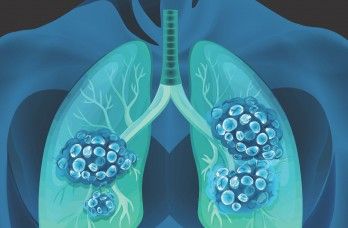Twice Daily, Hyperfractionated Thoracic Radiotherapy Effective at 60 Gy in SCLC
A phase 2 trial demonstrated a median overall survival of 43.5 months at 60 Gy compared with 22.5 months at 45 Gy in patients with limited-stage SCLC.
With regards to overall survival and progression-free survival, 60 Gy of thoracic radiotherapy was superior to 45 Gy in patients with limited-stage small cell lung cancer.

Thoracic radiotherapy twice daily at a dose of 60 Gy in 40 fractions prolonged survival and was well tolerated compared with a dose of 45 Gy in 30 fractions in patients with limited-stage small cell lung cancer (SCLC), according to a phase 2 trial (NCT02041845) published in the Journal of Thoracic Oncology.1
Overall, the median overall survival (OS) was 33.3 months, with 34.1% of patients alive after 5 years. In the 60 Gy group, the median OS was 43.5 months (95% CI, 30.4-56.6) vs 22.5 months (95% CI, 17.2-28.0) in the 45 Gy group (HR, 0.68; 95% CI, 0.48-0.98; P = .037). The 2-year survival rates were 74.2% and 48.1%, respectively (OR, 3.09; 95% CI, 1.62-5.89; P = .0005); the 5-year survival rates were 39.3% and 28.4%.
In the multivariable analysis, the survival difference between the 60 Gy and 45 Gy groups remained significant (P = .031). Increasing age was an independent negative prognostic factor for survival (HR, 1.03; 95% CI, 1.00-1.06), and female sex was a positive prognostic factor for survival (HR, 0.68; 95% CI, 0.47-0.97; P = .035).
Overall, the median progression-free survival (PFS) was 15.0 months. In the 60 Gy group, the median PFS was 18.6 months (95% CI, 11.6-25.6) vs 10.9 months (95% CI, 8.7-13.2) in the 45 Gy group (HR, 0.76; 95% CI, 0.53-1.08; P = .13).
In the multivariable analysis, no PFS difference was observed between the 60 Gy and 45 Gy treatment groups (HR, 0.75; 95% CI, 0.53-1.07; P = .12). The only baseline characteristic significantly associated with PFS was female sex (HR, 0.61; 95% CI, 0.43-0.87; P = .007).
“These final efficacy analyses confirm that twice-daily [thoracic radiotherapy] of 60 Gy in 40 fractions was superior to the established schedule of twice-daily 45 Gy in 30 fractions in our study cohort,” wrote lead study author Tarje Onsøien Halvorsen, MD, PhD, of the Department of Clinical and Molecular Medicine at the Norwegian University of Science and Technology in Trondheim, Norway, and the Department of Oncology of St. Olavs Hospital at Trondheim University Hospital, with coauthors.
The trial enrolled a total of 176 patients who were randomly assigned, in a 1:1 ratio, to receive thoracic radiotherapy at 60 Gy in 40 fractions (n = 89) or 45 Gy in 30 fractions (n = 81). Treatment consisted of 4 courses of intravenous cisplatin at 75 mg/m2 or carboplatin at 5 to 6 mg/mL per minute area under the curve, on days 1 to 3 every 3 weeks. Thoracic radiotherapy was planned to start 20 to 28 days after the first course of chemotherapy, and all patients received 2 fractions of radiotherapy per day, with a minimum of 6 hours between fractions, and 10 fractions per week.
Inclusion criteria include being 18 years or older, an ECOG performance status of 0 to 2, confirmed SCLC, and limited stage according to the International Association for the Study of Lung Cancer.
The trial’s primary end point was 2-year OS. Secondary end points included OS, PFS, toxicity, response rates, thoracic relapse rates, and health-related quality of life.
The mean scores for physical and cognitive function declined from baseline to year 5: physical function fell by 10 points in both groups, and cognitive function fell by 21 points in the 60 Gy group and by 18 points in the 45 Gy group. Global quality of life remained stable.
Maximum dysphagia was reported at week 8, with no clinically significant difference between either treatment group. At 1 year, however, patients in the 60 Gy group reported more dysphagia, with a difference in mean scores of 9 points.
At the time of final analysis, 54% of the 60 Gy group and 63% of the 45 Gy group progressed; 42% and 46%, respectively, experienced distant metastasis (P = .60). In the 60 Gy group, 23% of patients experienced an intrathoracic relapse compared with 37% of patients in the 45 Gy group (P = .037); 12% and 17%, respectively, had an intrathoracic relapse at first relapse (P = .37). There were no detected differences in median time to progression for patients with isolated relapse in the thorax as first progression (P = .10) or in median post-progression survival (P = .11).
After the first relapse, 85% of the 60 Gy group and 76% of the 45 Gy group received second-line chemotherapy (P = .26).
Regarding acute radiotherapy-related adverse effects (AEs), grade 3 esophagitis occurred in 21% of the 60 Gy group and 18% of the 45 Gy group (P = .83); grade 3 to 4 pneumonitis and grade 5 pneumonitis occurred in 3% and 1% of the 60 Gy group. Per long-term AEs, physician-reported eating or swallowing dysfunction occurred in 6% of the 60 Gy group and 8% of the 45 Gy group (P = .57), and physician-reported cognitive impairment occurred in 1% and 9%, respectively (P = .025). Stenting or blocking of the esophagus occurred in 2% of the 60 Gy group.
Reference
Grønberg BH, Killingberg KT, Fløtten Ø, et al. High-dose versus standard-dose twice-daily thoracic radiotherapy in limited-stage SCLC: final survival data, long-term toxicity, and relapse patterns in a randomized, open-label, phase II trial. J Thorac Oncol. 2025 Apr 19:S1556-0864(25)00696-3. doi: 10.1016/j.jtho.2025.04.007.
Newsletter
Stay up to date on recent advances in the multidisciplinary approach to cancer.
Elevating the Quality of Cancer Care via Cross-Department Collaboration
Experts from Sibley Memorial Hospital discuss how multidisciplinary work has enhanced outcomes such as survival and resource use at their institution.